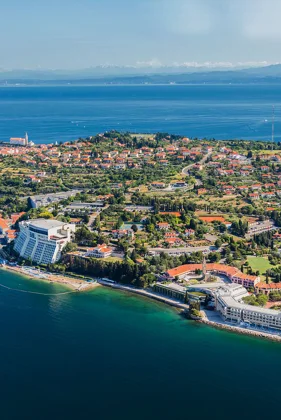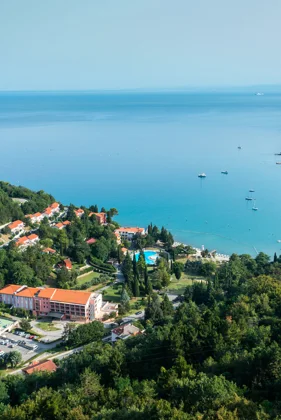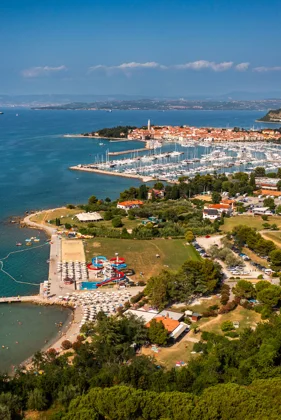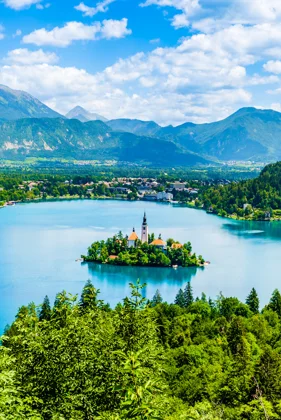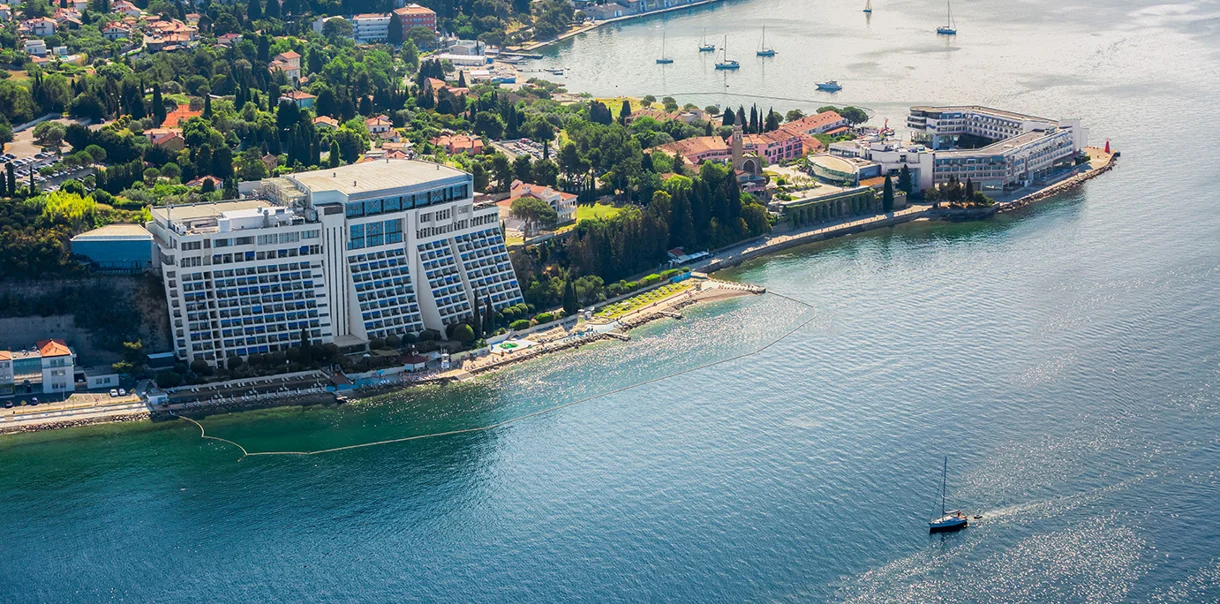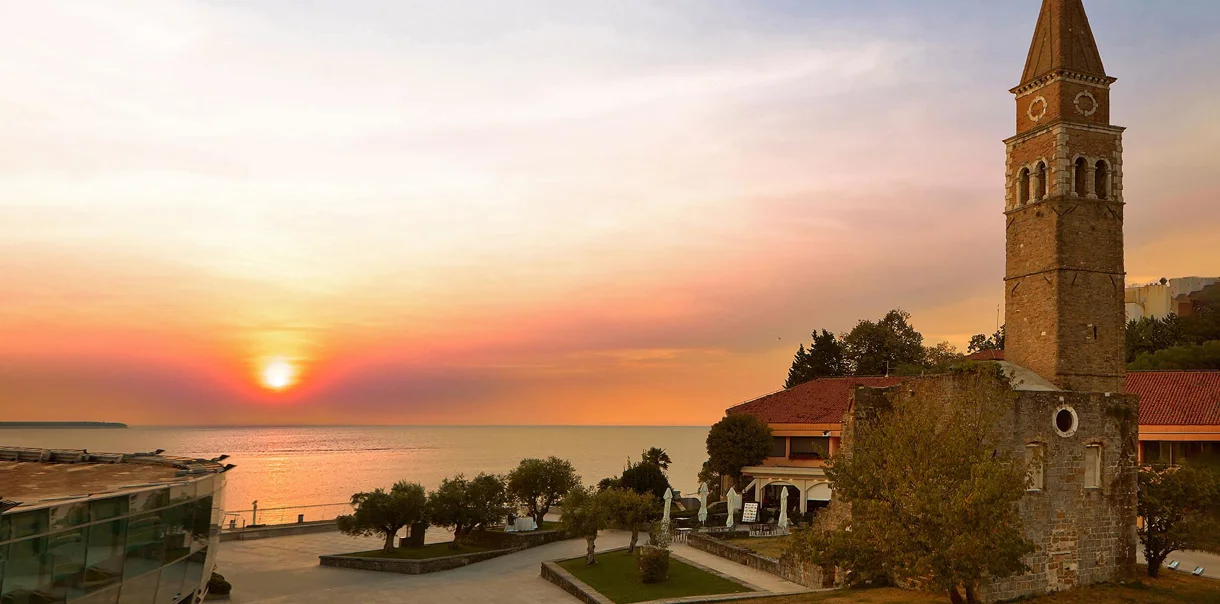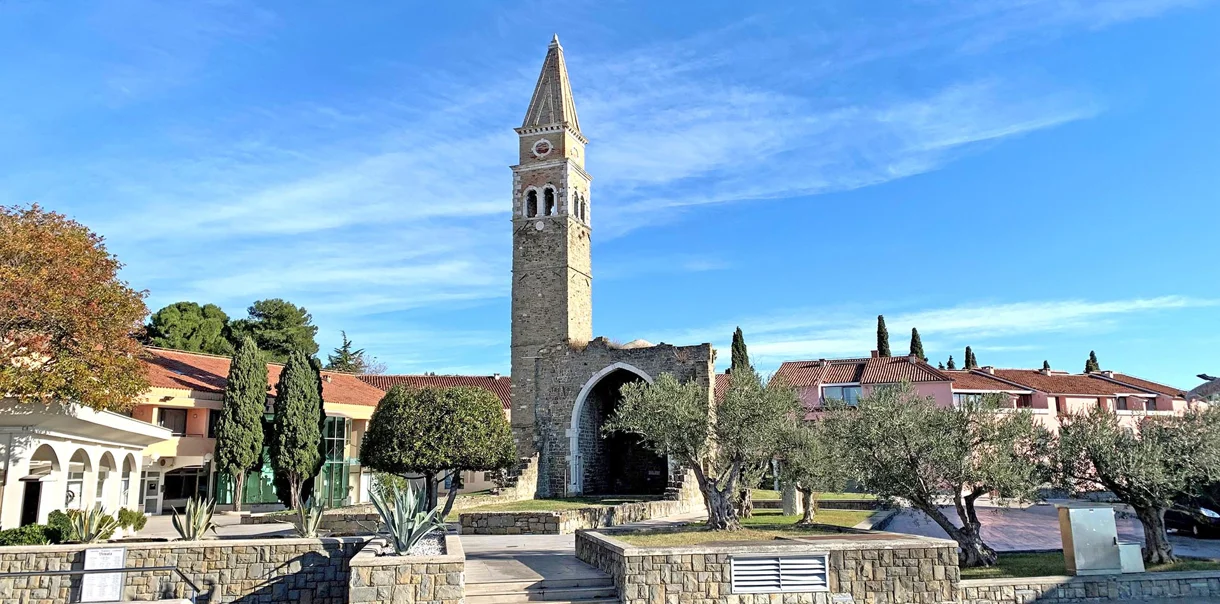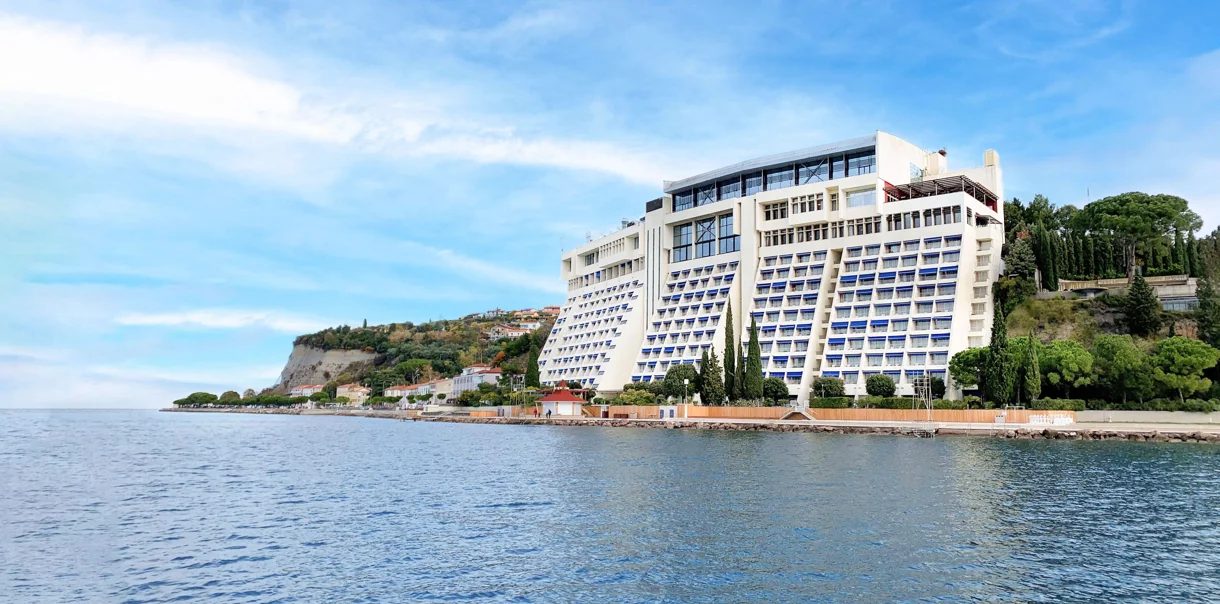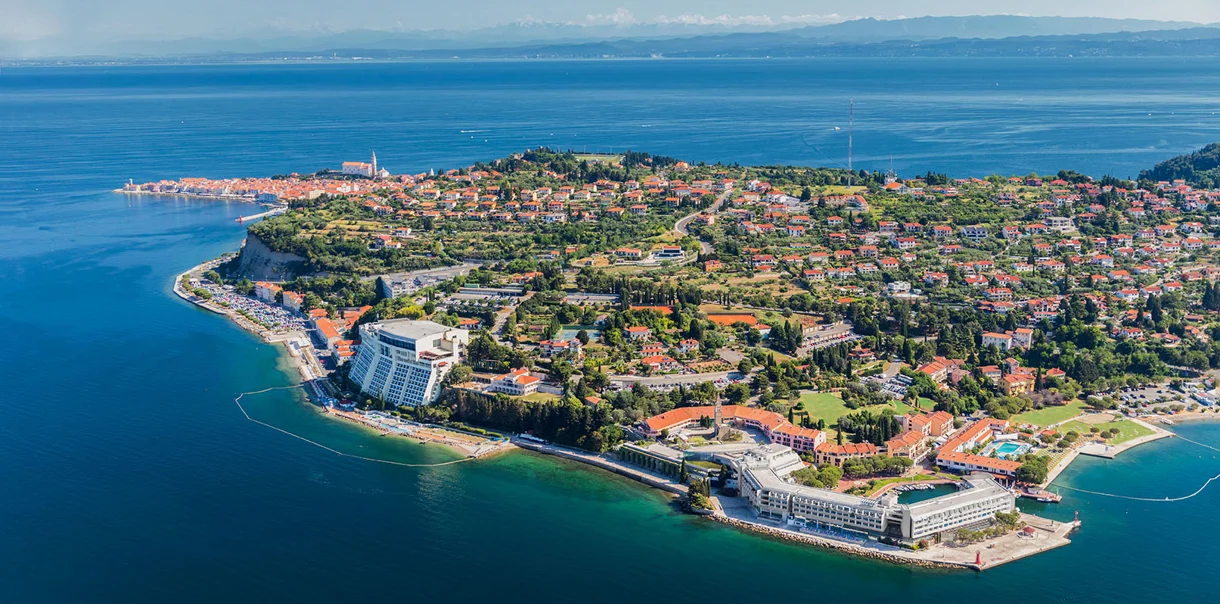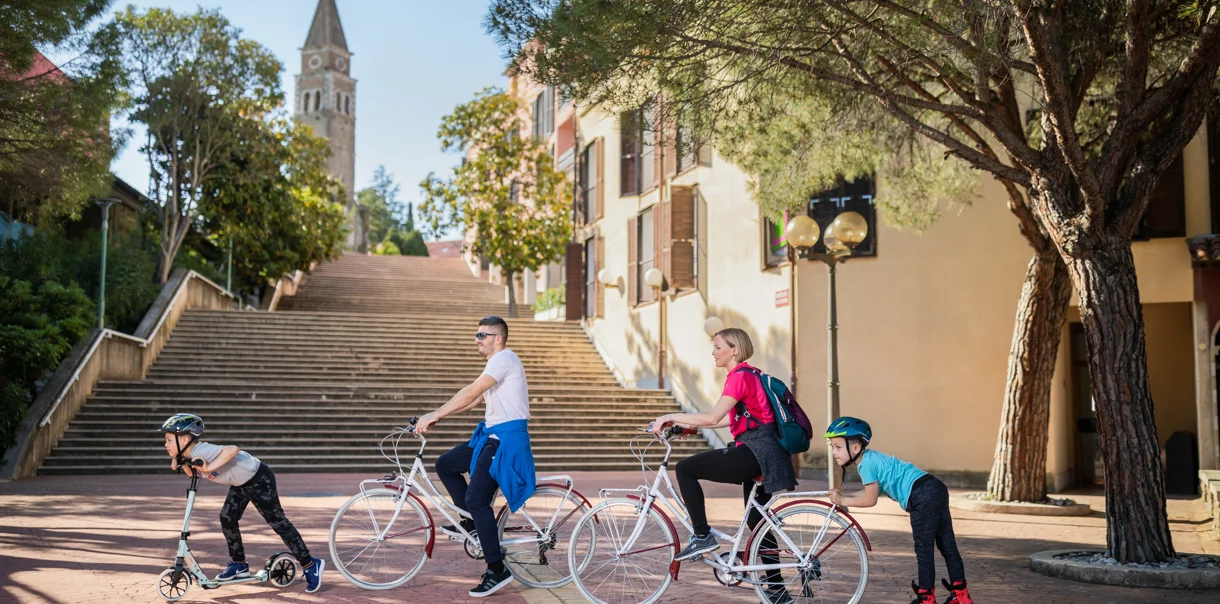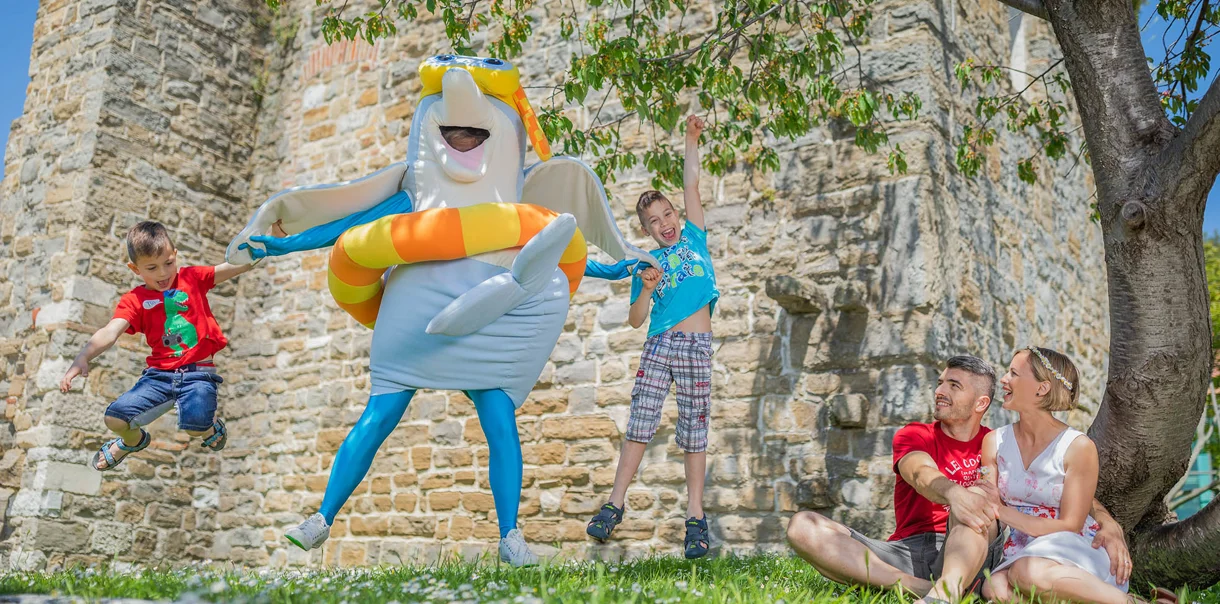Bernardin, a place with tradition and a rich cultural heritage
There is an inscription on the façade of the remains of the once mighty and important church of St. Bernardin, which tells us the year of its construction, who founded it and whom it was dedicated to… Moreover, it also intrigues us to search for the truth regarding the origins of St. Bernardin Resort.
As we admire the stone ruins, which today are encircled by the modern architecture of the tourist complex of Hoteli Bernardin, the view opens in all directions. Here we can gaze into the past for a moment and feel as it revives our awareness and our pride for the rich cultural heritage of this place.
If we research the stone structure in the few written sources available, many questions are left unanswered. What we can be sure of is that in the Middle Ages the church of St. Bernardin stirred a yearning for a sense of belonging, for a deeper connection with faith and God. From the point of view of the life principles of that time, this was a simple search for shelter, support and security.
It all started with the Romans, or did it?
During the Roman times there was only greenery here and sailors found refuge in the bay where there was also a small port. In the fifth century the Romans were defeated by barbarian peoples, in the sixth century the area was populated by the Slavs, after them came the Byzantines in the seventh century, the Franks in the eight, Italics people in the ninth and the Kingdom of Germany in the tenth. During the next few centuries the town fought bravely for its independence, freedom and autonomy and led a skillful policy of (non)cooperation with the Venetian Republic, Dubrovnik and Split. The inhabitants of Piran were guided by Christian piety, which had a substantial role in the construction of churches and monasteries in Piran and it also influenced the acceptance of two of the most important orders of seraphim from Assisi; minorites and observants.
Who built the church and the monastery of St. Bernardin?
The initiative for the foundation of the church and monastery was given by the fervently devoted community of Piran and the first representative of the order, John of Capestrano.
In 1451 Saint John of Capestrano (1386 – 1456), a reformer, preacher, observant Franciscan who was also called “the Apostol of Europe”, stopped in Bernardin. He inspired the inhabitants of Piran, who asked him to allow them to build a church outside the town’s walls, which would be dedicated to the new saint from Siena, Saint Bernardin of Siena (1380 – 1444), and a monastery for his observant brothers.
What is the story behind the message that saved the church?
Hanc Sacram AEdem, & Domum Religiosam
Cives Pyranenses pyssimi
Sancto Bernardino, &Fratribus Minoribus
Dedicarunt M.CCCC.LII
The construction of the church and monastery in the calm location was a cause of envy. The opposing parties cited Pope Boniface VIII’s ban, according to which the minorite friars couldn’t build their monastery without a special authorisation. Thus, the church and monastery were almost not finished. However, the above mentioned message arrived in a letter from Pope Nikolai V from Rome on the 1st July 1452 and dispersed all doubts. The story had a happy conclusion, as the buildings were finished after the dispute was settled and the observant brothers could move in.
This is the first church in the world dedicated to St. Bernardin of Siena
The date of the church’s consecration – 1452 – is engraved on the façade. They couldn’t have chosen a more curative, spacious and pleasant location for the sacred building. The church was built on a hill above the sea, close to the church St. Mary of the rosary and above the port baring the same name, where it overlooks the sea, Piran, Portorož and the whole Slovenian Istria, the vast extension of the saltpans and fishing areas, and is embraced by olive tree grooves.
Where does the name Bernardin come from?
Bernardin of Siena was a great preacher and a people’s missionary. His tomb lies in the church of St. Bernardin in the town of Aquila in Abruzzo. Bernardino Albizeschi, who was later also called the “new Francis”, was born on 8th September 1380 in Massa Carrara Marittima, close to Siena. After the premature death of his parents he was raised by his relatives. He was a very talented boy and began studying at the University of Siena when he was only eleven years old, but God’s providence had other plans in store for him. When a plague epidemic erupted in 1397, seventeen-year-old Bernardin concluded his studies and tended to the sick and dying of his town. When the epidemic was over, he became sick himself and fought for his life for various months. During this time he decided to enter in the minorites order. When he regained his strength in 1402, he took the monk’s cloth in Siena and was ordained in 1404. During his whole life he always advocated consistency in life.
This great missionary followed the footsteps of St. Francis by preaching about love, marriage and peace. Despite his austerity, he was so popular that he was honoured as a saint already during his lifetime. Among his pupils was also St. John of Capestrano, who always supported his work. Bernardin of Siena died on 20thMay 1444 in Siena at the age of sixty-three. Six years after his death, in 1450, Pope Nikolai V proclaimed him Saint Bernardin of Siena.
What did the church and monastery look like when observant brothers lived there
The main church nave was adorned by ceiling paintings, which were created in the years 1743 – 1745 by the Venetian painter Antonio Rebolo. Among the works of art was also an important piece from Vivarini’s school, the painting of St. Bernardin, which is now located in St. Ann’s church in Koper. It is known that the friars protested about the transfer of the works of art and books. The monastery had a rich library with many interesting and important books, which were lost later in time. The monastery was of medium size, it had dormitories, i.e. sleeping quarters, workrooms and isolation cells, where the friars could carry on various tasks.
According to bishop Naldini (source: Cerkveni krajepis Justinopolis – Koper), the church had various marble altars and was decorated with numerous works of art, among which also the altar painting of Aliseo Vivarini senior, the Mother with the sleeping infant (1489). In 1802 baron Stefano Carneo gave the painting as a gift to emperor Francis II, who resided in Vienna. There’s an interesting story regarding this painting: in 1968 Paolo Tedeschi published two letters written by baron Stefano in the newspaper La Provincia. The letters were addressed to the father of the famous poet Besenghi degli Ughi from Izola. The letters recount that the minorite friars protested when they learnt that the painting of the Mother with the sleeping infant was to be moved to Vienna.
You can also find other archeological remains in Bernardin
During construction work on almost the whole hill of Bernadin, from the shoreline in the southeast to the road from Piran towards Portorož, many archaeological remains were found, such as a Roman tombstone, fragments of Roman amphorae and bricks, all in the upper earth layers. Because of these findings, smaller archaeological probes were dug on the south-eastern and eastern side of the remains of St. Bernardin’s church. The oldest remains were the foundations of the cloister of the Franciscan monastery and the destroyed cemetery, probably dating to around 1452 as the church itself.
What goes on today?
Today each passerby stops by the church, some just to admire it and maybe discover a piece of Bernardin’s story. Others take a seat in the shade of olive trees and admire in silence the view over the sea, which opens up from the International terrace in front of Hotel Histrion. Without a doubt all visitors take a photograph of the church, as it is very photogenic: you can find some great shots on our Instagram profile if you need proof. Create your own unforgettable holiday stories on the Slovenian coast with @hotelibernardin.




